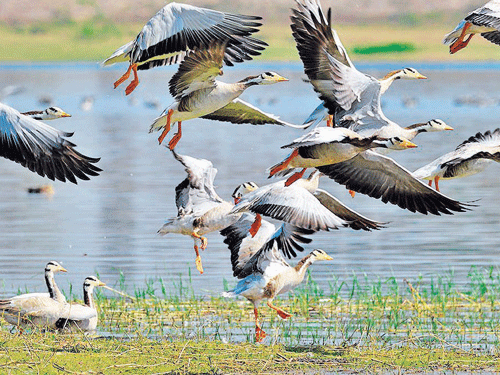
The number of birds migrating to South Karnataka from Siberia and Mongolia before the onset of winter has dwindled by more than half over the last two decades, the tentative figures for 2015 show. Loss of habitat, especially the encroachments on lakes, is the main reason.
South Karnataka, with its rich aquatic bodies, has been a haven for migratory birds which arrive here to escape the harsh winters is parts of Siberia and Mongolia.
But their numbers have dwindled by over half in the last two decades, according to bird enthusiasts who have been surveying the birds for many years now.
Among the birds that arrive from northern Asia are bar-headed geese, garganey, shoveler, pin-tailed duck, pigeon and common teal, with the former being the most iconic. The birds arrive in November and are usually found in Hadinaru, Kaggalipura lakes and in the backwaters of Kabini reservoir. They go back in the second week of February.
The birds travel at least 5,000 km, flying above the Himalayan Mountain Range to reach parts of South Interior Karnataka, said Guruprasad, an amateur bird-watcher and naturalist.
“Bar-headed geese do not breed here. During winter, temperatures reach sub-zero levels in Siberia and Mongolia. Bar-headed geese and other birds start migrating before the onset of winter,” he told Deccan Herald.
A Shivaprakash of Mysuru Nature group, which has been monitoring the migratory birds during winter for more than two decades, said their number had dwindled from nearly one lakh to 40,000.
“Two decades ago, even Karanji and Kukkarahalli lakes inside Mysuru city used to be populated by one or other species of these birds. Annual estimates of the migratory birds from Siberia and Mongolia varied from 80,000 to one lakh. However, as per the tentative figures of 2015 survey, their numbers do not exceed 40,000 now,” he said.
Giving an example, he said the number of bar-headed geese used to be more than 2,500 in the region. “In the last few years, rarely do a thousand of them arrive. The average is about 400-500,” he said.
Shivakumar blamed the loss of habitat for the dwindling number of birds.
“Most lakes these birds used to settle in have been encroached upon. Bar-headed geese, for instance, prefer lakes with clean water, which are fast disappearing. Besides, some birds also are victims of poaching,” he said.
Birds, which used to be distributed across Mysuru district during winter, have started to choose a handful of water bodies as habitations. Conserving these water bodies is the need of the hour, he added.
